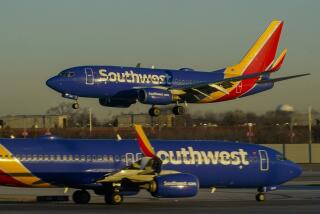Once upon a time, we could love an airline
- Share via
Loving an airline sounds about as likely as feeling a fondness for an insurance company. Air travel is too expensive and hassle-plagued to inspire emotional attachment. But that used to be different, as passengers who flew Pacific Southwest Airlines know.
The San Diego-based carrier holds a special place in the hearts of many, especially those who flew PSA in the ‘60s and ‘70s, the glory days when the airline summed up everything that was groovy and freewheeling about California. Beautiful stewardesses (or “stews,” as they were proud to be called at the time) wore go-go boots and miniskirts with petti-pants underneath to keep the reach for the overhead luggage compartment decent. Fares were low, endearing PSA to college students and those in the military. Food was not served, but cocktails, at $1 each, flowed freely.
Above all, PSA was the beloved little guy, battling for dominance in the West Coast market against such major carriers as Western, TWA and United.
Sold to US Airways (then USAir) in 1988, PSA has become a piece of commercial aviation history, at once quirky and significant for its influence on the fun-in-the-sky flying style and development of today’s low-cost carriers.
For this reason alone, it’s worth a trip to the San Diego Aerospace Museum in Balboa Park, where a permanent exhibit on the airline opened in September. It is populated with memorabilia donated by former employees who still smile when they think of PSA, appropriate for an airline whose slogan was “Catch Our Smile.”
“It was just cool,” said Tom Houle, a PSA captain from 1979 to 1988. Houle, now living in San Antonio and flying for US Airways, made a special trip to the museum to see the PSA display. I bumped into him by chance standing in the reproduction white-frame PSA ticket office looking at a row of mannequins in PSA stewardess uniforms. They ranged from a demure kelly green suit worn in the mid-’50s to the outrageous orange-and-pink mini-dress of the early ‘70s. Gentlemanly Houle said he always tried to look away when one of the stews bent over but finally gave in and checked out the view and was astonished to discover hot pants under the skirts.
I asked Barbara Wendt, a US Airways flight attendant who was a PSA stew from 1971 to 1988, how she felt about wearing the uniform that screams “sexist” to us now. “We were the height of fashion,” she said. “We were hot.”
Wendt said that besides being subjected to routine weight checks, a standard practice in the airline industry then, PSA stewardesses had to wear plastered-down side curls, hairpieces and false eyelashes. Together with the uniforms, such cosmetic touches made them look as though they had just stepped out of a giant pink Barbie doll case in the sky.
As the exhibit shows, style was only part of PSA’s success formula. The carrier -- affectionately known as “Poor Sailors’ Airline” -- was started in 1949 by Kenneth Friedkin, then owner of a San Diego flight school who recognized the need for cheap transportation between Southern California and the Bay Area. His price for a one-way ticket from San Diego to Oakland was about $15, according to “PSA: The Story of Kenny Friedkin’s Pacific Southwest Airlines,” by Gary Kissel. That was significantly less than the prices charged by other carriers.
Friedkin managed to undercut his competitors and attract volume business partly by focusing on California routes in the beginning. This kept PSA, then under the jurisdiction of the Public Utilities Commission of California, from having to comply with costly regulations imposed on interstate carriers. (Southwest, today’s most successful low-cost airline, adopted the same approach, starting small in Texas.)
Friedkin also kept his planes continually in the air. By the ‘60s, PSA’s fleet included six Lockheed Electra L-188s, though they were kept so busy that observers noted there seemed to be a dozen in the air at any one time. Eventually, the airline offered service as far afield as Seattle, Albuquerque and Puerto Vallarta, Mexico, and made the ever-popular L.A.-San Francisco run once every 30 minutes.
So why, one might ask, isn’t PSA around now? The exhibit cites airline industry deregulation, over-expansion and a spike in fuel prices as factors.
As the ‘70s waned, there also was a certain loss of innocence. Three PSA stews posed nude for the May 1980 issue of Playboy. And there were PSA crashes in 1978 and 1987, the first especially horrifying: a midair collision over the airline’s hometown that killed 144 people.
Former employees Houle, Wendt and pilot Randy Prine, who helped spearhead the PSA exhibit, remember happier times, the family feeling inside the company, the unbuttoned attitude and scrappy approach to problem solving. “It would be hard to start a PSA now,” Prine told me. “But if we could have kept it going, no one could touch us.”
San Diego Aerospace Museum, 2001 Pan American Plaza, Balboa Park, San Diego; (619) 234-8291, www.aerospacemuseum.org.
More to Read
Sign up for The Wild
We’ll help you find the best places to hike, bike and run, as well as the perfect silent spots for meditation and yoga.
You may occasionally receive promotional content from the Los Angeles Times.






